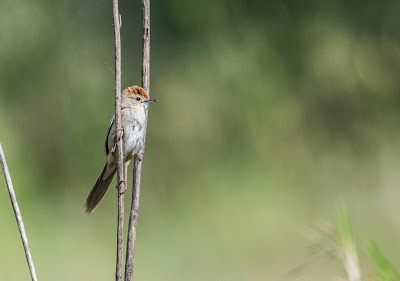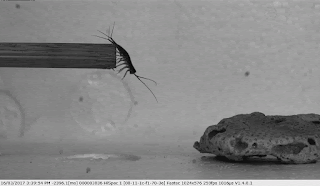Lizard tricks: overcoming conflicting requirements of speed versus climbing ability by altering biomechanics of the lizard stride
 So recently I managed to publish a paper in the Journal of
Experimental Biology about my dissertation work looking at the locomotion in
Australia's biggest and baddest lizards the monitor lizards. I called it
'Lizard Tricks', not only cause I think they are doing something neat, but
because I think what we see in these lizards would be a nice little engineering
principal we could use in the design of robots or something else equally
awesome. Ignoring for now that it took me over 6 years to figure this all out,
I'd like to try and explain how I finally got to this point, and where we are
with our understanding of locomotion in these beasts.
So recently I managed to publish a paper in the Journal of
Experimental Biology about my dissertation work looking at the locomotion in
Australia's biggest and baddest lizards the monitor lizards. I called it
'Lizard Tricks', not only cause I think they are doing something neat, but
because I think what we see in these lizards would be a nice little engineering
principal we could use in the design of robots or something else equally
awesome. Ignoring for now that it took me over 6 years to figure this all out,
I'd like to try and explain how I finally got to this point, and where we are
with our understanding of locomotion in these beasts.
All good studies should always start as simply as possible, and
this is certainly where we began. In our earliest studies we compared the
morphology of different species with their retreat site (Thompson et al. 2008).
What we saw is that burrowing species tended to be different, from those that retreat
into tree hollows, as shown in this figure. Well it mostly works, except for V.
mertensi, the water monitor from the North of Australia. Look at him, sitting
in there among the other tree species.
But never mind, for most species at
least there is some morphological differences between these groups, which I
interpreted as an adaption between tree-climbing species, and those that spend
their time on the ground. I should mention here that the morphological
differences we did see, were not like those seen in other groups, such as short
legs in climbing species, but no matter I thought, we do see some differences. Great,
so I saw a different in morphology which was related to habitat. Now what?
Well following the paradigm of Arnold (1983), morphology is only
likely to be related to ecology, through its influence on performance
variables, since this is what selection can act upon. Not the shape of an animal per se, but how does that shape
confer an advantage to make it run faster, leap further and do all the other
lizardy things they do. And so this is what we did.
We examined the evolution of speed among varanid lizards, which
was related to size, but once we removed this size effect we found no
relationship between speed and climbing ability (Clemente et al. 2009a). We
also checked differences in endurance capacity, but found no differences there
either (Clemente et al. 2009b). So what was going on? What did these
differences in morphology mean, if they didn’t translate into differences in
performance. Well it turns out that they did, but we weren’t looking at the
right performance traits. But before I go into that I’d like to talk about
another project I was working on at the same time. I was interested in how
lizards change their gait as they get bigger.
 One impressive feature of monitor lizards is their huge variation
in size. So if you were interested in the effects of size on gait, you couldn’t
hope for a better group. The reason we expected gait to change in these
lizards, was a previous study by Andy Biewener (1989) in mammals showed a neat
principal, whereby small animals like cats and mice, had a crouched posture,
but big animals like horses and elephants, had a much more upright posture. The
idea was that bigger animals change their posture to be more upright since this
allows them to support more of their weight along the long axis of the bone, where
compressive stresses dominate, rather than bending the bone in the middle.
One impressive feature of monitor lizards is their huge variation
in size. So if you were interested in the effects of size on gait, you couldn’t
hope for a better group. The reason we expected gait to change in these
lizards, was a previous study by Andy Biewener (1989) in mammals showed a neat
principal, whereby small animals like cats and mice, had a crouched posture,
but big animals like horses and elephants, had a much more upright posture. The
idea was that bigger animals change their posture to be more upright since this
allows them to support more of their weight along the long axis of the bone, where
compressive stresses dominate, rather than bending the bone in the middle.  Think about a drinking straw, which is very easy to bend in half,
but much much harder to crush end to end. Anyway, this works really well in
mammals, I thought the same principal must be true for monitor lizards right?
Wrong. I had forgotten which group of lizards I was working with. Monitors are
like that awkwardly developing teenager, who just refuses to assimilate just
out of spite, so I shouldn’t have been surprised when there was no relationship
between upright postures and body size, as seen in this figure above. It varied
from species to species, but not in the way I expected.
Think about a drinking straw, which is very easy to bend in half,
but much much harder to crush end to end. Anyway, this works really well in
mammals, I thought the same principal must be true for monitor lizards right?
Wrong. I had forgotten which group of lizards I was working with. Monitors are
like that awkwardly developing teenager, who just refuses to assimilate just
out of spite, so I shouldn’t have been surprised when there was no relationship
between upright postures and body size, as seen in this figure above. It varied
from species to species, but not in the way I expected. After some searching I did find another possible mechanism through
which lizards could mediate size related stress in limb bones (by changing
femur rotation), but it didn’t explain where the variation in upright posture
was coming from. And that is how I ended up at the current study.
After some searching I did find another possible mechanism through
which lizards could mediate size related stress in limb bones (by changing
femur rotation), but it didn’t explain where the variation in upright posture
was coming from. And that is how I ended up at the current study.
You see climbing species are faced with certain problems that us
land walking species don’t have to face, the most obvious of which is falling
off the dammed thing you are climbing, to escape whatever douchebag animal is
trying to eat you. One way climbing species avoid falling is by lowering the
body centre of mass which reduces the torque due to gravity.
 Becoming less upright is a good way to do this, and this is
certainly what these lizards appeared to be doing. They adopt a sprawling
posture, which is kind of like being forever in the pushup position, close to
the ground. But the variation I had seen in upright posture before, was infact
better represented by whether lizards lived in trees or not.
Becoming less upright is a good way to do this, and this is
certainly what these lizards appeared to be doing. They adopt a sprawling
posture, which is kind of like being forever in the pushup position, close to
the ground. But the variation I had seen in upright posture before, was infact
better represented by whether lizards lived in trees or not.
So part of my problem was solved in that I had figured out where
the variation in posture was coming from, but this created another problem,
speed. You see there are two ways of becoming faster, one is to take longer
steps the other is to take more steps in the same period of time. Becoming more
upright is popular among terrestrial lizards, not only because it looks cool
(check out that cover photo), but also because it increases the effective
length of your limbs and allows you to take longer steps, increasing stride
length and therefore speed. So we looked at the biomechanics of the stride, and
this is exactly what we found among terrestrial monitors. Terrestrial lizards
take longer steps as they run faster. However, climbing lizards, for perpetual
pushup related reasons we talked about above can’t do this, so we might expect
them to be quite a bit slower. But as we saw above this is not the case, there
was no difference in speed between climbing and terrestrial monitors.
So how are climbing monitors keeping up with their terrestrial
brethren? Well the answer it seems is that they are changing the other methods
of modifying speed, stride frequency. By taking more steps more often, they
have overcome the problems of staying stable while climbing while at the same
time not sacrificing speed. And so that is the story of Lizard Tricks. There is
still lots to figure out, like whether these climbing lizards, with their different
gaits are actually putting more stress on limb bones, but for now that’s a
problem for future Chris to deal with.





Another way to do it would be to accept falling as an occupational hazard and evolve ways of surviving long drops?
ReplyDeleteYes this is certainly a possibility, and would work well for smaller animals which have a higher safety factor. Though falling itself can have other detrimental effects, for example, you must now expend the extra energy to get you back up into the tree, and also if the fall is large, you might end up a long way from your preferred retreat. I recall a study on ants, which are unharmed from falls, but have developed the ability to glide back to the tree trunk, since following a large fall, the ant may be unable to relocate its nest.
ReplyDelete